
As part of the public art project Exemplary, student interns commissioned an original dance piece in honor of Katherine Dunham, PhB’36. They also organized an origami folding event, a cloud festival, and so much more. (Photography by Jason Smith)
An ambitious public art project. Five overstretched interns. What could go wrong?
On January 27, it seems like everything is going according to plan.
The five interns working on the Exemplary public art project—Juan Cardenas, William Hu, Suttyn Simon, Xueqi Sun, and Miki Yang, all Class of 2025—spent Autumn Quarter interviewing professors, polling students, and thinking deeply about what it means to be an exemplary UChicagoan. (Read part one of “Making an Example.”)
Now they’re ready to do something. And they have a generous budget—$40,000 from the College’s Curricular Innovation Fund—to do it with.
When Laura Steward, the University’s curator of public art, originally envisioned Exemplary, she thought the project would focus on writer Susan Sontag, AB’51. The students blew up that simple idea last quarter.
Instead, they want to honor three alumni: Sontag; dancer-anthropologist Katherine Dunham, PhB’36; and astronomer Carl Sagan, AB’54, SB’55, SM’56, PhD’60.
But also—a faculty member: meteorologist Tetsuya “Ted” Fujita, aka “Mr. Tornado,” who taught at UChicago from 1953 to 1990.
And also—a group of staff members: contracted workers, specifically dining services workers.
Not one project, but five.
It’s a daunting task to accomplish in just two nine-week quarters. But Steward and the interns seem entirely undaunted, and at the January 27 meeting—almost halfway through Winter Quarter—it seems difficult, but doable.
The Sontag project is well underway. Quotations from Sontag’s writings will be printed on large adhesive labels and installed among the portraits in Hutchinson Commons. This was Steward’s idea. She’s been plotting for years.
The interns have chosen the quotes. They have measured and remeasured the wall panels—which look identical but actually are all different sizes. Now they need to collaborate with a designer to make it happen.
Sitting under one of the few women’s portraits (Marion Talbot, dean of women in the early University), the group is going over the designer’s proposed budget. “He went big,” Steward says: $40,000 just for Sontag. But that amount has to cover all of their big ideas.
For Sagan, a “Cosmos watch-a-thon,” a mini-festival of his groundbreaking television show. Also origami star-crafting.
For Dunham, a dance performance. Suttyn has suggested working with the Ruth Page Civic Ballet Training Company, where she was a trainee dancer last year; she abandoned professional ballet to study at the College.
For the workers, a collection of short video interviews screened on monitors: “a Nam June Paik kind of vibe,” Steward says.
For Fujita … something. To be determined.
Steward walks the students through the line items of the Sontag bid, including “a contingency of $2,000,” she says.
“What’s a contingency?” Juan wants to know.
“A contingency is for things that happen that you didn’t plan for. The less you know, the more contingent the project is—the more ‘unknown unknowns,’” she says. “It’s just good to have a little padding in the budget.”
In case something should go wrong.
Exemplary project #1: Original dance performance honoring Katherine Dunham, PhB’36
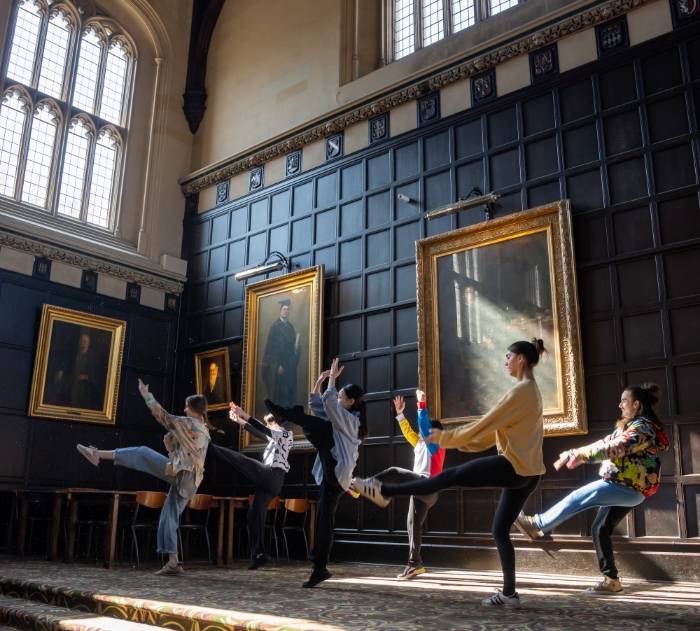
The interns wanted to honor Dunham during Black History Month, and they just make it. They meet with Victor Alexander of the Ruth Page Civic Ballet Training Company on February 3. His three-minute piece is staged February 28 in Hutchinson Commons.
At 11:30 a.m., 12:30 p.m., and 2 p.m., with no warning, drummer Victoria Boateng bursts loudly into rhythm. Six trainee dancers, dressed in street clothes, emerge from the lunchtime crowd and move among the tables, making their way to the platform at the west end of the room.
Alexander’s original choreography called for dancing on the tables as well as the floor, but the tables were too wobbly—something he discovered the day before. There are a few minor technical glitches, but the audience is too astonished to notice. They are not too astonished to applaud.
Exemplary project #2: Cosmos screening and origami star-folding in honor of Carl Sagan, AB’54, SB’55, SM’56, PhD’60

The Sagan event, for complicated reasons, takes place over two days in two venues across campus from each other.
On Saturday, April 8, there’s a full-day Cosmos watch-a-thon at the Logan Center.
On Sunday, April 9, members of CHAOS, the Chicago Area Origami Society, lead a two-hour workshop on folding origami stars in the lobby at the Smart. Attendance is small but enthusiastic: “This is a wonderful event,” second-year Sylvie Badur gushes. “You guys have done an amazing job.”
The Tuesday after the Sagan festival, the temperature is 78 degrees—a welcome treat in mid-April. The interns have gathered on the patio outside the Logan Center’s café: a calm, relaxing space for an anxiety-provoking conversation. The Sontag installation is not going well.
The original designer had to drop out for health reasons. Steward scrambled to find a replacement. Now there’s an issue with the adhesive: it pulls the varnish off the walls. “What’s a little varnish between friends?” Steward quips. The facilities department did not see it that way.
The stickers could be installed with tiny pins, which would leave just a pinhole behind. Facilities was not thrilled by that. Their suggestion: varnish the walls before applying the labels. The printer nixed that idea, since the varnish would need at least a week to dry.
Just five and a half weeks remain in the academic year. The workers have not been interviewed yet; the project on Fujita has not even been decided. The interns need to move on. But Steward’s contact in Facilities is being slow to respond.
“You could send one of us,” Juan says.
“I can cry on command,” Suttyn offers.
“We can’t change the site,” Juan says.
“We already did the measurements,” Miki says.
“This Spring Quarter has been so incredibly cursed,” Suttyn says.
Steward is remarkably sanguine—probably because she’s pulled off much riskier projects. In 2017, for the 75th anniversary of the first self-sustaining nuclear reaction, she commissioned a pyrotechnic piece by artist Cai Guo-Qiang, who detonated 500 pounds of explosives on the roof of Regenstein Library. “We had to stop helicopter traffic,” Steward says. “Everyone involved, up to [then University president Robert J.] Zimmer, was a little nervous.”
Time is running short in the meeting, too, so they turn to other projects. For the workers, Chartwells, the University’s catering contractor, has stepped in to help. Chartwells’ videographer will shoot and edit the videos for free. The interns just need to book a campus space and ask the questions.
That leaves Fujita, the tornado expert: how to celebrate him? At a previous meeting, the students had discussed doing something with cloudlike cotton candy.
“Hear me out,” says Suttyn. “I found a company that can make logos into clouds.” They could rent the company’s machine and make clouds on the Main Quad.
“During Summer Breeze,” Miki suggests.
Stress and exhaustion are making everyone a little punchy. “No one wants to wear a tornado costume? Tornado dress? Tornado cape?” Steward asks. She looks pointedly at William, the fashionista of the group. He shakes his head.
Suttyn is assigned to look into the cloud machine; Miki into a supplier of cotton candy.
Exemplary project #3: Exhibition of quotations from the writings of Susan Sontag, AB’51
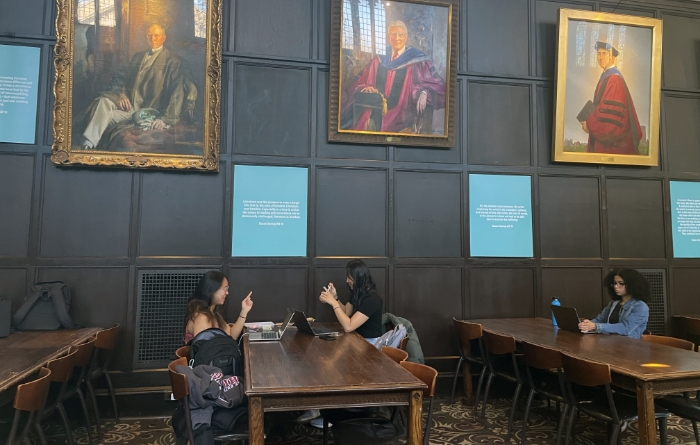
The Sontag exhibition is finally up. The Sontag quotes have been printed on heavy blue card stock, rather than stickers, and installed with 22-gauge pins, “about half the size of a thumbtack,” explains Steward. She confirmed with her father, a retired second-generation hardware store owner in rural Arkansas, that the pins would hold.
There are some thought-provoking juxtapositions.
Under Hanna Holborn Gray, the first, and only, woman president of the University (1978–93): “A woman’s face is potentially separate from her body … They establish her status as an ‘object.’”
Under Robert Maynard Hutchins, University president and then chancellor (1929–51), who was famous for his quips and bon mots: “To be a poet requires a mythology of the self … When the poet self dies, the person dies.”
But there’s no time to revel in the success of Sontag. There are video interviews with dining services workers to be done.
On a sunny morning in late April, the group has set up in the Reynolds Club South Lounge. Juan is interviewing Ana Valencia in Spanish while Suttyn looks on: “I’m not conversational enough to ask a question.”
Next up is Joanne Henderson, who has dressed for the occasion in a black blazer, black pearl-studded beret, leopard-print scarf, and chunky rhinestone earrings. “I love the entire ’fit,” says Suttyn. She explains the project as Henderson gets settled in front of the camera: “We want to highlight the exemplary parts of the University.”
“If you come from a working-class background,” Juan adds, “you know that without the workers, nothing gets done.”
“Wow,” Henderson says. “That’s awesome.” Steward fusses with the microphone pinned to Henderson’s scarf. “You guys make me feel so special.”
In the interview, Henderson explains she was born in Mobile, Alabama: “I’m a Southern belle.” She came to Chicago with her parents in 1968, at age 6, and “was raised in the projects.” She attended Reavis Elementary and King High School, has worked as a nurse and a school bus driver, and raised three children. “I love food and I love fashion,” she says. At the University, she enjoys setting up the tables, arranging the fruit: “I make it look beautiful for y’all.”
Exemplary project #4: Cloud festival honoring Tetsuya “Ted” Fujita
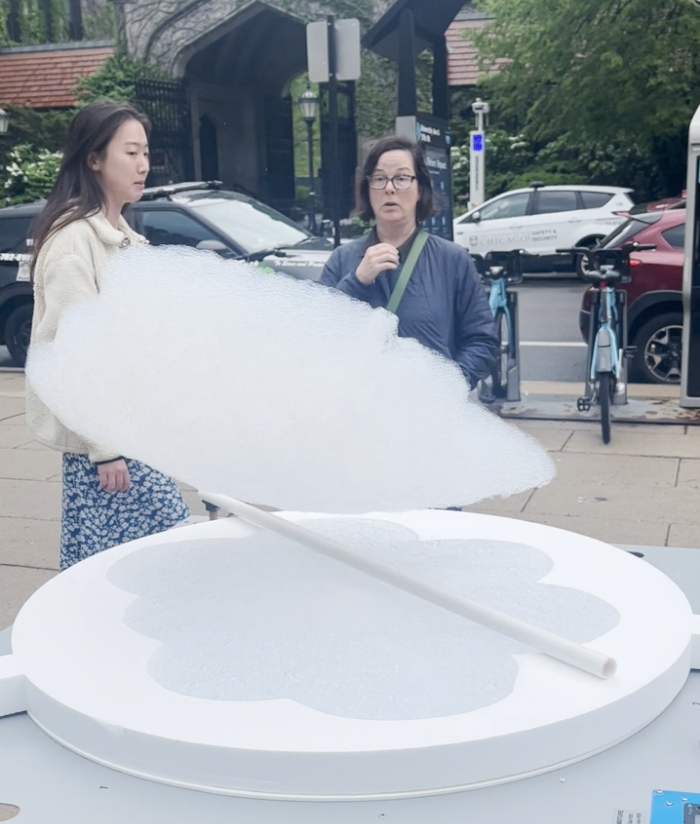
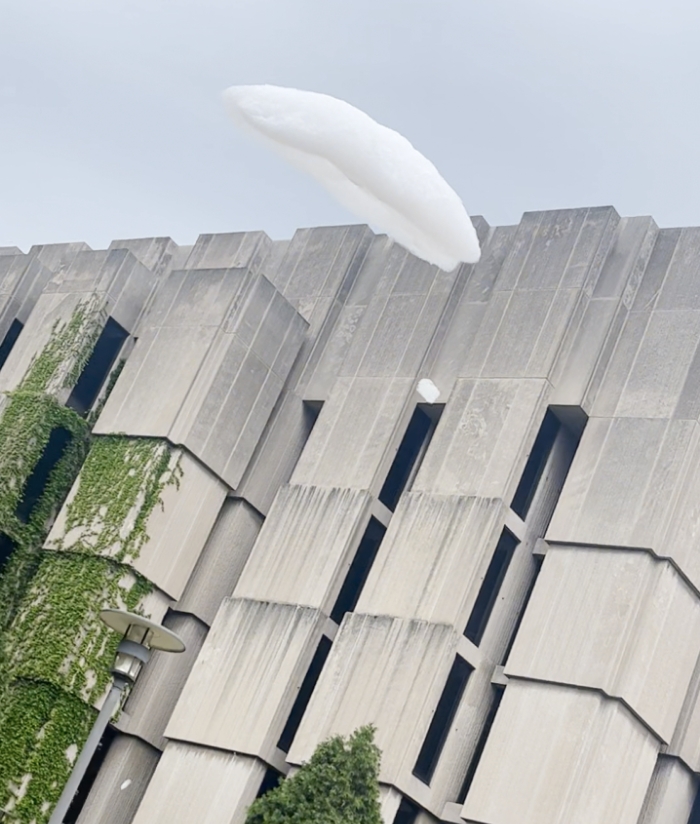
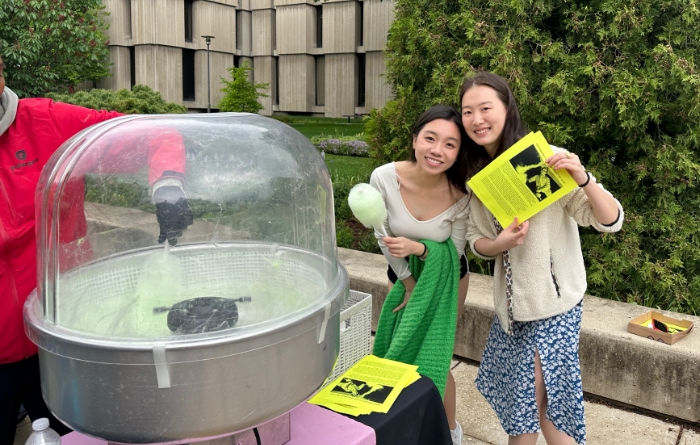
Outside Regenstein Library, foamy, cartoon-like clouds float through the air on Saturday, May 13 (the event had been planned for the day before, but had to be postponed due to rain). The clouds, made of “Flogo juice,” as Miki calls it, were “essentially baby shampoo.”
“It may have been the most successful project of all,” Steward says later. The students who stopped by “will never forget who Fujita is.”
By May 23, the interns’ final meeting, the video project is still not done. Unhappy with the quality of the interviews, the videographer wants to scrap them and do them over. “He may be imagining this project to be a marketing piece,” Steward says, rather than what the interns were aiming for: artsy videos focusing on the workers as individuals. “I have a feeling he has a very different end product in mind.”
“I’m willing to do it next fall,” Juan says. The Exemplary internship was paid, but he offers to work for free: “I want to see it finished.”
For last year’s pilot public art project, 100 Views of Lake Michigan, Steward held a capstone event where the interns spoke about what they had learned. But this year’s group, having created five separate projects of their own design—one of which remains incomplete—is bled dry.
So instead they’re informally hashing over Exemplary while enjoying a celebratory dinner at Nella on 55th Street. (Except for Xueqi, who has not been lured out even by the promise of carb-heavy Italian food. “She locks herself in her room when she’s studying,” Miki explains.)
Which project did they feel most invested in?
“Obvious answer for me,” says Suttyn: Katherine Dunham. She would have loved performing in a piece like that. Not just because of the “cool new choreography,” but because it was a learning experience for both dancers and audience.
“The Sontag project,” says Miki. She had read Sontag’s essay “Against Interpretation” before the internship, but “I wasn’t thinking ‘Oh, she’s such a snake.’ Laura was like, ‘She’s a snake.’” In watching interviews with Sontag, Miki enjoyed the way she would flip questions back on the interviewer: Why are you asking this question? What’s the point?
“In freshman year, I remember the first time I was in Hutch, I saw all the portraits up there, all male,” Miki says. She liked the decision to represent Sontag not with a generic portrait—like all the men in suits—but with her words, interrogating them.
“The problem with the Sagan day is that nobody came,” Steward says. (The date had to be changed and there wasn’t much time for promotion.) “Other than that, it was perfect. The man is exemplary—the physicist who writes poetry. And the series is amazing. His groovy three-piece suits, his hair, the sideburns.
“I just wish—you know, it was ten hours,” she says. “Ten hours of public television from the early 1970s.” The interns and a few other attendees were in and out. But Steward, like a captain whose honor requires going down with the ship, spent the entire day at Logan watching Cosmos—along with one other young man.
“That dude will do great things,” says Miki.
“In the movie version of this, he’ll rise up and lead the people,” says Steward.
“He was fasting as well,” Juan observes.
William chooses Sontag: “It had the most problems to solve, and I like solving problems.” After all the difficulty with the installation, on a “random Wednesday morning” the exhibition was up. “It was like a slap in the face,” he says. “A good slap in the face.”
Juan was most invested in the workers project, an idea he proposed and fought hard for, “but I really enjoyed the Katherine Dunham performance,” he says, especially the element of surprise. “We’re not asking for permission. She’s coming in whether you like it or not.”
“Xueqi would say it wasn’t a particular project,” Steward says. “She was most engaged by the research phase. Talking to professors, trying to understand what it was to be exemplary.”
By email from China after the quarter ends, Xueqi casts a third vote for Sontag. Although she was the main organizer of the Sagan festival, she felt more creatively invested in Sontag: she had compiled the quotes, assigned them to their panel positions, and written the exhibition description. “I saw people taking photos of the panels, sharing their personal thoughts on the quotes, or even just asking others what’s going on in Hutch.”
William had noticed that too: “I saw people post on Sidechat.”
“Making fun of it,” Suttyn points out.
“Doesn’t matter,” says Juan. “They’re paying attention.”
“As far as what I learned,” says Steward, “I think I did you a disservice in letting this thing be such a big, sprawling, all-singing, all-dancing project.” Next year, she could define the scope more narrowly. But should she? “You would lose the open thinking section. I also wanted you to have the opportunity to fail,” she says: learning how to fail, and get back up, is an important life skill. “You want dessert, right?”
They all do. William orders two—one for now and one for later, while studying. “I will have a spoon,” Steward tells the waiter.
“Also, we are undergrads,” says Suttyn. “As wonderful as giving us leeway is, all of us here are like, 20.”
“I wanted to give you permission, or to show you that you don’t need permission,” says Steward. “You give you permission.”
It’s been a warm, festive, somewhat nostalgic meal, despite the looming pressure of finals. As the discussion wraps up, Steward pays with a University credit card. A few minutes later, the waiter returns apologetically. There’s a glitch with the card. It’s been declined.
Steward doesn’t even blink, just whips out her own.
